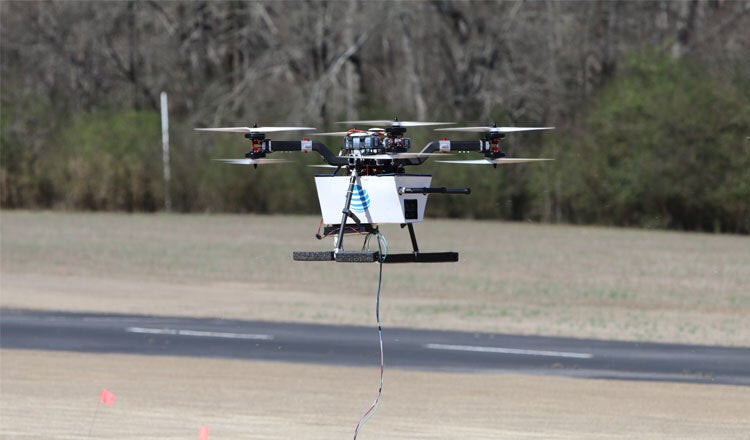If you see a Flying COW, don't be alarmed; it's just AT&T temporarily improving its 5G signal

Wireless providers have all sorts of cool tools that they have access to whenever they need to make a quick adjustment to improve 4G or 5G service under certain conditions. One such piece of equipment is called a COW., and no, you cannot milk it nor can you turn it into a roast beef sandwich. COW is an acronym for Cellular On Wheels. Whenever a carrier needs a short-term boost to improve its signal in a particular area, it calls for a COW to be driven into the area.
AT&T is turning to drones to tweak its 5G coverage in certain areas when needed
These trucks, which can be rented for $4,000 per month, come with all the gear needed to expand coverage during a major sporting event (such as the Super Bowl or a winner-take-all World Series game 7), or a major conference. Any situation where the carrier anticipates much higher demand for cellular service than normal could require the use of one or more COWs.
While a COW is technically a short-term solution to a temporary problem affecting cellular service, some providers have been forced to use a COW as a long-term solution when the budget comes up short or the landscape of a certain area isn't ideal for the construction of new cell towers.

A Flying COW drone provides enhanced 4G and 5G coverage to AT&T subscribers
Using a COW. is a lot less expensive since all that the carrier is responsible for is the leasing, electricity, and backhaul. And AT&T's new COWs can be deployed even faster since they have the ability to bypass ground traffic. How is this possible?
Using new technology, the "W" in COW represents "Wings," not "Wheels." That's right, TechRadar states that the nation's third-largest carrier has a fleet of drones that it can fly into certain areas where 4G and 5G signals are beamed down as needed.
The carrier says that its intention is to use the drones to help first responders, mountain rescue services, and others get a strong connection to 4G or 5G to help with a rescue. But drones do have limitations, especially when it comes to how long they can fly. Currently, AT&T can get two hours of flight time from its drones compared to 30 minutes for consumer-oriented models.
AT&T hopes to improve the flight time of its Flying COWs
AT&T says that it is working to increase the flight times of its drones. "We are currently working through many exciting technical challenges to expand the capabilities of our Flying COWs," said Art Pregler, Unmanned Aircraft Systems (UAS) Program Director, AT&T.
Pregler adds, "We’re working to autonomously fly without tethers for months without landing, using solar power to provide secure, reliable, and fast 5G connectivity to large numbers of users over wide geographic areas. This solution may one day help bring broadband connectivity to rural and other under-served communities across the US and elsewhere."
Pregler adds, "We’re working to autonomously fly without tethers for months without landing, using solar power to provide secure, reliable, and fast 5G connectivity to large numbers of users over wide geographic areas. This solution may one day help bring broadband connectivity to rural and other under-served communities across the US and elsewhere."
Another area where a 5G Flying COW could be of some assistance is under rugged conditions where the terrain makes it impossible for a truck to be driven into the area to improve the 5G coverage. So next time you see something flying in the sky and aren't sure what it is, you might find yourself saying, "look up in the sky. It's a bird. It's a plane. It's a flying COW." And someday you might be enjoying extremely fast 5G service away from home all thanks to an AT&T mobile hotspot powered by a Flying COW.
Follow us on Google News









![A new Android bug is making it impossible to install new apps. Are you affected? [UPDATE]](https://m-cdn.phonearena.com/images/article/176703-wide-two_350/A-new-Android-bug-is-making-it-impossible-to-install-new-apps.-Are-you-affected-UPDATE.webp)

Things that are NOT allowed:
To help keep our community safe and free from spam, we apply temporary limits to newly created accounts: